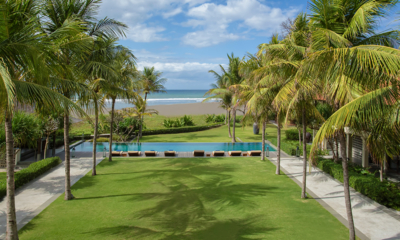Gianyar is a Balinese regency stretching from the centre of the island to the southeast coastline. Characterised by verdant rice fields and stunning black sand beaches, Gianyar offers a taste of the real Bali away from the tourist trail. Ubud, the cultural and spiritual heart of Bali, is also located in the Gianyar Regency.
Gianyar Overview
Gianyar is one of eight regencies in Bali and with a population of some 500,000, it’s the second most densely populated regency on the island after Badung (home to Kuta, Seminyak and beyond). The sprawling regency is a patchwork of rice fields and rainforest, framed by a dramatic stretch of black sand beaches on the southeast coast. To this day, Gianyar maintains the feel of the “real” Bali, away from the more touristic bustle of the southern areas. A notable exception to this rule is Ubud, a bustling centre of arts and culture located in central Gianyar.
Gianyar attracts travellers looking to experience Bali beyond the tourist trail and to get better acquainted with the island’s rich cultural heritage. Much of Gianyar has stuck to its rural roots and is dotted with local Balinese villages, rice fields and temples. There are also a few busy hubs in the area, most notably the towns of Gianyar and Ubud. On the coastline, Gianyar is pierced by a major highway connecting busy South Bali towards Padangbai, Candidasa and Amed in East Bali. Gianyar’s beaches are covered in volcanic black sand and remain largely unvisited, save for local fishermen and adventurous surfers.
Planning Your Trip to Gianyar
Much of Gianyar (save for bustling Ubud) remains a relaxed destination throughout the year, attracting an ideal number of travellers looking to experience the “real” Bali. Our Gianyar travel guide aims to give you the essential information, list the most popular things to do in Gianyar, provide more information on locations you want to visit, and finish with some inspiration from our travel writers. For more information on events and festivals taking place throughout the year, check out our comprehensive Bali guide.
Gianyar Weather
Bali is pleasant all year round! May through September has the best weather (drier, less humid) and is the best time for many activities including diving and surfing. November though March is rainy season – though rainfall is never excessive so you can do most activities except volcano treks.
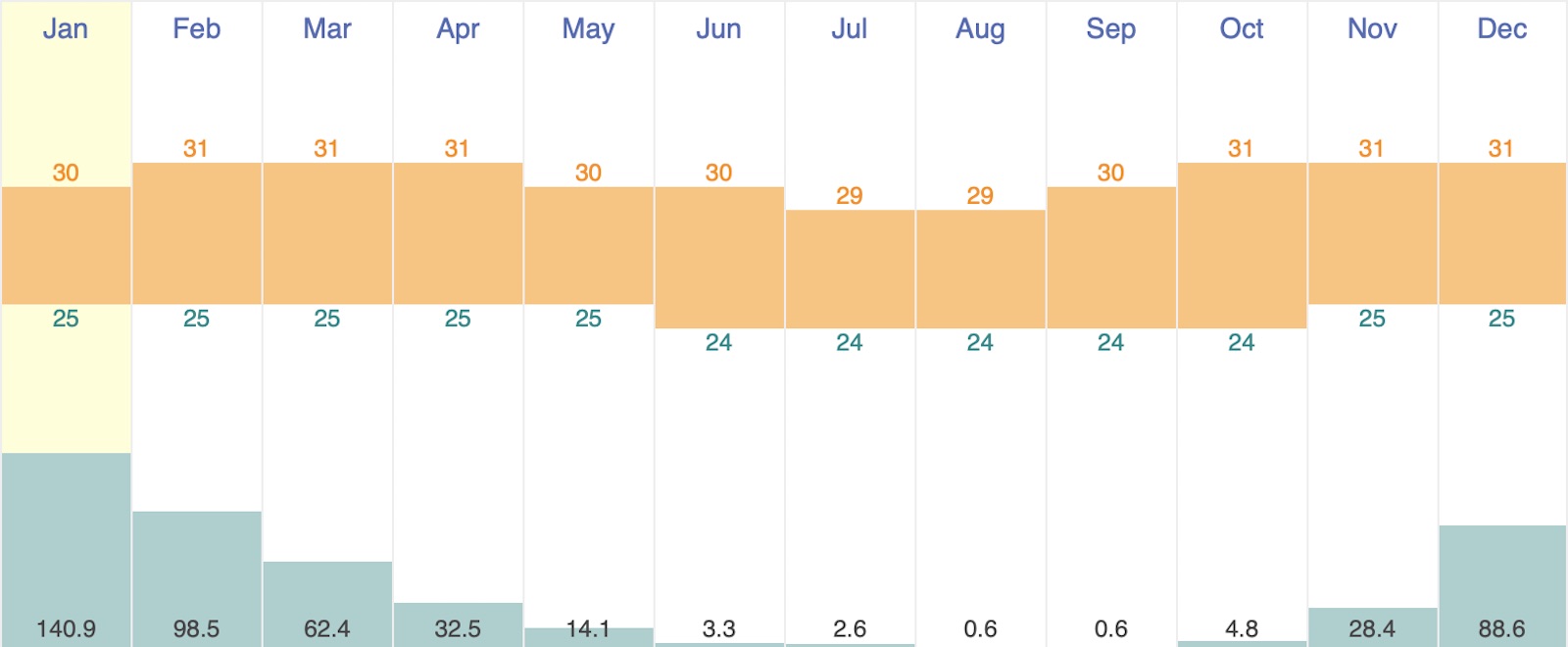
AVERAGE TEMPERATURE
The temperature ranges from 24 degrees to 31 degrees all year round.
AVERAGE RAINFALL
Rainfall ranges from 0cm to 140cm during the wet season.
Things to See & Do in Gianyar
Gianyar is the perfect destination for soaking up Bali’s stunning natural scenery and rich cultural heritage. The area is also a prime destination for enjoying traditional Balinese arts, whether that means visiting an art gallery, enjoying a hypnotic dance performance or simply witnessing a colourful procession down the street.
Spa Treatments
Gianyar is the perfect place to get immersed in Bali’s healing traditions, with countless spas to pamper your senses. Ubud and its surroundings in particular offer options to suit every budget, ranging from down to earth local parlours to extravagant luxury spas. For ultimate indulgence, you can also enjoy a massage or other spa treatments in the privacy of your villa. Many of the large luxury villas even come with dedicated spa rooms purposefully designed for this.
Shopping
Perhaps surprisingly, Gianyar is also a worthy destination for some retail therapy. Gianyar is an important area of art and craftsmanship so it’s a great place for picking up some souvenirs. One of the best places is the Sukawati Art Market where you can pick up eclectic keepsakes to bring back home with you. The local markets do require you to haggle for the prices, so be sure to bring your a-game!
Tours & Activities
Located in central Gianyar, the cultural hub of Ubud is home to some of the most famous landmarks on the island, including the Sacred Monkey Forest Sanctury, Goa Gajah Temple and the Tegalalang rice fields. Further up north, Pura Tirta Empul is a beautiful water temple where visitors can join a cleansing ceremony with the locals.
Besides art and culture, Gianyar is famed for its natural scenery. Tegalalang rice terraces offer some of the most iconic views on the island, but you will encounter stunning rice paddies (minus the crowds) simply driving around the area. Gianyar is also home to stunning natural waterfalls, including Tegenungan, Tukad Cepung and Goa Rang Reng.
You can also get your heart pumping in Gianyar. White water rafting is a popular activity in the area, with most tours taking place along the Ayung River. This is a scenic and energising way to get a real feel of Bali’s lush tropical beauty. Another great way to explore the area is by hopping on a bicycle. While it’s technically possible to simply hire a bike and to head out on your own, we highly recommend joining a guided tour to make the most of the experience. Having a knowledgeable local guide to take your through the most scenic routes and picturesque Balinese villages will give you a better understanding of local life on the island.
Though most people associate Gianyar with verdant rice paddies and lush rainforest, the region is also home to ruggedly beautiful beaches covered in velvety black sand. Keramas Beach in particular is favoured by experienced surfers looking to avoid the crowds. The currents can be strong and unpredictable, so swimming is generally not advised. Though the overall feel along the coastline remains very much off the radar, a handful of beach clubs have sprouted up in the area.
Eating & Drinking in Gianyar
Dining in Gianyar can range from epic fine dining in a stunning tropical setting to down to earth meals in a humble local warung. Gianyar is also a great place to sample some authentic Balinese cuisine. For more details on local food, check out our comprehensive Bali guide.
Restaurants
Ubud has emerged as one of the culinary hotspots on the island and offers amazing, world-class dining with a focus on plant-based cuisine. The cuisine offered will vary greatly depending on where in Gianyar you’re staying. While Ubud offers a huge concentration of restaurants and cafes to suit every budget and taste, other areas remain more lowkey and local and finding a spectacular venue for your next meal might take a little more digging. One of the best options is to have the chef at your villa to whip up a real feast for you and your entourage.
Nightlife
Unlike the buzzy southwest coastline, Gianyar doesn’t offer a pulsating nightlife, with most venues closing well before midnight. But not to worry – an ice cold Bintang beer is never too far out of reach and many restaurants (particularly those in and around Ubud) serve amazing tropical cocktails to quench your thirst. A nigh out in Gianyar might mean a long dinner surrounded by lush nature, relaxed drinks with your posse while a local band plays in the background – or maybe taking in a spectacular dance performance at Ubud palace. There are a few beach clubs on the coastline where you can enjoy a round of drinks with your group. Surprisingly, even landlocked Ubud has its own “no-beach beach clubs!”
Gianyar Neighbourhoods
Gianyar is a large area – the regency spans almost 400 square kilometres – and offers varied scenery and ambiance depending on where you’re staying. For the easiest access to tourist facilities, it’s best to stay in or around the centre of Ubud where you’ll be surrounded be endless restaurants, shops, galleries, yoga studios and spas. This means ease of access, but due to the area’s huge popularity the atmosphere can get hectic and too touristic for some travellers’ liking.
As soon as you head out from Ubud centre, you can feel life slow down. This is what people mean when they talk about discovering the “real” Bali. Gianyar offers stunning natural scenery, with villas, hotels and resorts surrounded by rice fields, rain forest and local village life. Staying in these more rural areas does mean distances will be greater and you will need a car to get around – a small price to pay for staying in the real heart of Bali.
Heading away from the rice fields and towards the coastline, you’ll be greeted by the dramatic black sand beaches of southeast Bali. Saba, Keramas and other beaches in this area tend to be quiet and lowkey and you’ll often share the beach only with a handful of locals and die-hard surfers. The shoreline is home to some of the most stunning and luxuriously secluded beachfront villas on the island.
Gianyar & Surrounds
Gianyar is a sprawling recency stretching from the southeast coastline to the lush heart of the island, offering landscape varying from black sand beaches to verdant rice paddies. Ubud is undoubtedly the most famous part of the area, known world wide as the capital of Balinese culture, artistry and spirituality. To the west, Gianyar is neighboured by Tabanan, a large regency known as the “rice bowl of Bali”, home to UNESCO-protected rice fields and the iconic sea temple of Tanah Lot. East of Gianyar, you can visit the petite regency of Klungkung which is followed by the relaxed seaside town of Candidasa. Driving south of Gianyar, you will reach the charming region of Sanur or heading southwest, the bustling area of Seminyak, Canggu, Legian and Kuta.
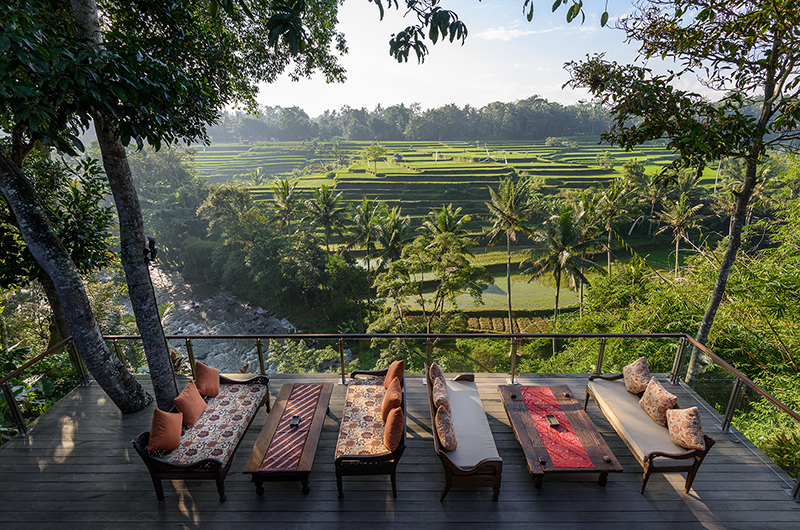
Ubud
Ubud, the cultural heart of Bali, is famed for its rice paddies, ancient temples and rich cultural heritage.
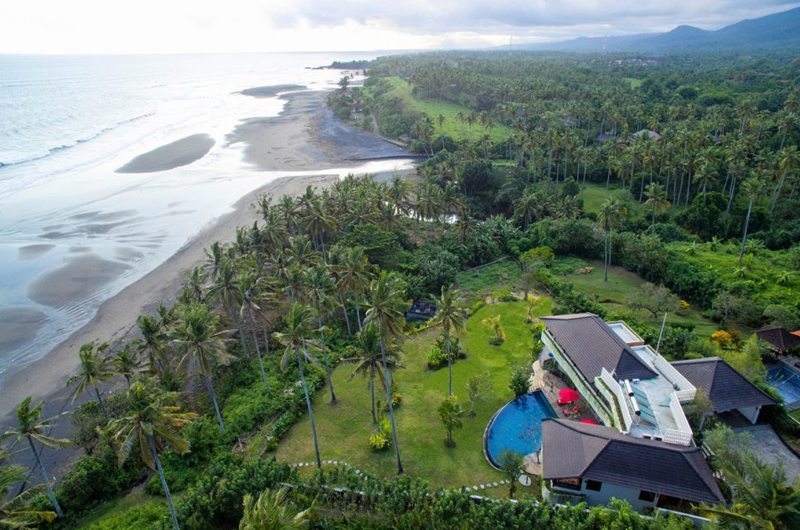
Tabanan
Tabanan is a verdant region characterised by rice fields, secluded beaches and amazing luxury villas.

Klungkung
Klungkung is a town of great historical and cultural significance, surrounded by traditional villages.
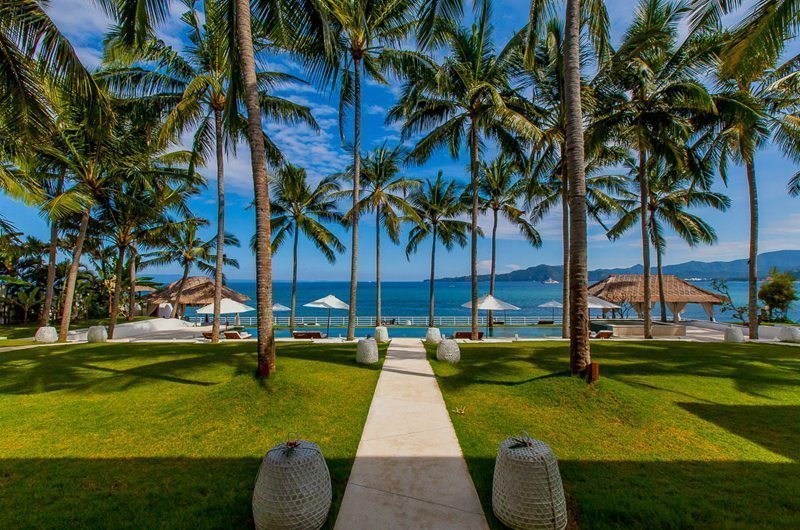
Candidasa
Candidasa is a relaxed coastal town with stunning waterfront villas and a feel of the old Bali.

Sanur
Sanur is a mature resort town with a calm beach attracting families and mature travellers.

Seminyak
Located on the southwest coast, Seminyak is home to all the best restaurants, beach clubs and boutiques.
Gianyar Villas
Ministry of Villas offers around 50 hand-picked villas in Gianyar. As Gianyar is not a major tourist destination, prices here tend to be lower than other parts of Bali. You can find a spectacular beachfront villa in Gianyar at a much lower price than you would in more crowded areas in the south. Prices in Ubud are higher than other parts of Gianyar due to the area’s huge popularity.
Prices start at around USD $150 per night for a one-bedroom villa and range to over USD $15,000 per night for a 10-bedroom luxury villa. All of our villas come with professionally trained staff. Many villas offer personalised services including: butlers, chefs, nannies, 24-hour security personnel, drivers and other services you won’t find in a hotel.
Practical Information
Getting There
Ngurah Rai International Airport is the only airport in Bali, centrally located in Tuban in South Bali. The airport is commonly called Denpasar Airport, in reference to the island’s capital city. The busy airport serves over 20 million passengers a year and as the second busiest airport in Indonesia (after Jakarta), Ngurah Rai is well connected to international destinations. Direct flights to Bali are available from Sydney, Melbourne, Singapore, Kuala Lumpur, Tokyo, Dubai and beyond. Carriers flying direct to and from Bali include Singapore Airlines, Cathay Pacific, Qatar Airways, Qantas, Air Asia and Jetstar. There are also some early plans of building a second airport in North Bali.
It is also possible to reach Bali by boat or ferry by landing at one of the neighbouring islands (Java or Lombok) which also have their own international airports. Ferries from Java to Bali arrive in Gilimanuk which is located about 3.5 hours from Gianyar (depending on where you’re staying). From Lombok, boats to Bali arrive in Benoa, Sanur, Serangan, Padang Bai and Amed. Padangbai is located about 90 minutes from Gianyar or if you’re staying along the coast, just 30-40 minutes.
Nationalities from over 160 countries are eligible for visa free entry into Indonesia. This means your passport will be stamped on arrival at the airport, allowing you to stay in the country for 30 days. For stays longer than 30 days, you will need to obtain a visa which will require further arrangements. Please note your passport must be valid for six months after your date of arrival in Indonesia.
AIRPORT TRANSFER
There is no public transport to get you from the airport to your accommodation, so the only option is to use a private driver or a taxi. Ministry of Villas can arrange a chauffeur to greet you upon arrival and escort you to your villa. This service is included for most villas when booking more than four nights. To avoid queuing at the immigration counter, we can also arrange a VIP airport service for guests. This service includes lounge access, allowing you to relax while waiting for your luggage.
AIRPORT TAXI
Alternatively, there is a taxi stand located next to the information desk at the international arrival’s hall, after you exit the small duty free shop. This desk offers fixed price and metered fares across the island. The listed fares are updated frequently, making it very challenging to find reliable, up to date pricing before arriving. Besides the official taxi stand, there are countless independent taxi drivers floating around the arrivals hall, offering rides at varying rates. It’s always easier to have a car arranged beforehand than trying to navigate the taxi jungle at the airport.
Getting Around
There are a few options for getting around Gianyar, so we’ve ranked them according to our recommendations for first-time travellers.
PRIVATE CAR
Hiring a private car and driver is the perfect way to explore the vast rice fields and deserted beaches of Gianyar. Ministry of Villas can arrange a private car and chauffeur for you. This little luxury is remarkably affordable and we can also help you arrange an itinerary, instructing your driver in advance.
RENTAL SCOOTER
If you’re travelling solo or with a partner, hiring a scooter can be a great way to explore Gianyar. Keep in mind that you should only ever hire a scooter if you have previous experience driving and hold a valid international driver’s licence. Scooter rentals usually start at around IDR 50,000 (USD $4) per day. Remember that driving without a proper helmet or an international driver’s licence will result in a fine if you get pulled over by the police.
ON FOOT
Gianyar is a large, sprawling area and as most travellers are looking to explore the area far and wide, walking is often not the best option. Local village roads tend to be quiet and if you’re only after a leisurely stroll, walking can be a great option. Just be mindful of the tropical weather – protect your skin from the sun and carry a reusable water bottle to stay hydrated.
TAXI
There are no official, metered taxis in Gianyar. In stead, you will encounter a seemingly endless supply of local drivers offering their services – you can also ask your accommodation to arrange a ride for you. With no metered taxis available, it is essential that you agree on the price before accepting any ride.
Etiquette
The Balinese are among the friendliest and most welcoming people on the planet. This is all the more reason to return the favour and be respectful towards the local culture. Like anywhere else in the world, common sense and basic human decency goes a long way. For more detailed information about local culture, language and safety in Bali, check out our comprehensive Bali guide.
SHOPPING & BARGAINING
Bargaining can be an enjoyable part of shopping in Bali… or it can be frustrating! To ensure a smooth exchange first decide what the item is worth to you, then ask the seller for their price – your first offer can be from one-third to two-thirds of that price. They are likely to respond with a counteroffer, which you can either accept or negotiate further. If you don’t like the price and you walk away there is a good chance the vendor will call out to you with a better (usually final) price. Keep in mind, if an agreement is reached, you’re committed – you should buy if your offer is accepted.
In late 2018, Bali’s governor banned single use plastic on the island, meaning shops, boutiques and supermarkets no longer give out plastic bags. When out and about, it’s best to carry a reusable bag with you.
TIPPING
Most restaurants and villas include a service component already so tipping is not expected, but if service is good, an additional cash tip is appreciated.
TELECOMMUNICATION
Indonesia’s country code is +62. Data speeds of 3G and faster is the norm across Bali. Local prepaid SIM cards are sold everywhere; any modern mobile phone will work. As of 2018, all prepaid SIM cards need to be registered which you can usually do with a copy of your passport directly at the shop where you purchase your SIM card. Prepaid SIM cards come loaded with pulsa (credit) or mobile data which you can later easily top up at other outlets. Most if not all minimarts and local phone shops can top off your SIM card when needed. Most villas provide broadband Internet and free Wi-Fi is common in cafes, restaurants, hotels and shopping malls.
Health & Safety
It’s important to note that compared to many places in the world, Bali is fairly safe. There have been some high-profile cases of visitors being injured or killed on Bali, but in many cases these tragedies have been inflamed by media sensationalism.
SWIMMING
Many of Bali’s beaches are subject to heavy surf and strong currents. The beaches in Gianyar are generally better suited for advanced surfing than swimming. Be careful when swimming over coral and never walk on it. It can be very sharp and coral cuts are easily infected. In addition, you are damaging a fragile environment. Lastly, water pollution is a problem in busy neighbourhoods. Avoid swimming near open streams flowing into the sea as they are often contaminated by run-off from built-up areas.
THEFT
Violent crime is uncommon in Bali, however bag-snatching from motorbikes and petty theft does occur. Take extra care with your phone if riding pillion on a motorbike as phones regularly get snatched from unsuspecting tourists using a navigation app. Otherwise, take the same precautions you would in any urban area and secure your money before leaving an ATM (and don’t forget your card!), don’t leave valuables on a beach while swimming, and use in-villa safes to store your valuables.
WATER
Tap water in Bali is not safe to drink. Bottled water is widely available and cheap, however Ministry of Villas encourages visitors to keep a reusable water bottle to reduce plastic consumption.
Travel Insurance
Travel insurance is absolutely essential for every traveller. A typical travel insurance policy will have coverage for a traveller’s main concerns, including trip cancellations, medical emergencies, travel delays, and lost luggage. Most policies are built to be comprehensive to protect travellers from a variety of events that may cause financial loss before or during their trip. Some policies specifically exclude ‘dangerous activities’ which can include scuba diving, renting a local motorcycle and even trekking.
Gianyar Stories
Gianyar wows with its cascading rice fields, rugged black sand beaches, amazing luxury villas and authentic Balinese charm. Check out our latest Gianyar blog posts written by experienced Ministry of Villas travel writers.


